Canon Ef 70-300 F4-56 Is Ii Usm Review
Verdict
Pros
- Fast autofocus
- Up-rated prototype stabilisation
- Build quality
- Offers groovy residuum between portability and paradigm quality
Cons
- Hood costs £75 extra
- Lacks a weather seal effectually lens mountain
- Highlights can look difficult-edged towards the long stop of the zoom
Key Specifications
- Review Price: £499.99
- 17 elements in 12 groups construction
- f/iv-5.6 maximum discontinuity
- ane.2m minimum focus distance
- 80 x 145.5mm
- Canon EF mountain
- 710g
- 9 diaphragm blades
- 67mm filter thread
What is the Canon EF 70-300mm f/4-v.vi IS II USM?
The Canon EF seventy-300mm f/four-v.six IS II USM is a mid-range telephoto zoom lens for Catechism'south DSLR cameras, incorporating both optical image stabilisation and a new, fast and silent Nano USM motor for autofocus. It can be used on cameras with both APS-C ('ingather') and full-frame sensors, and also on Canon's mirrorless EOS M serial cameras via the Canon EF-EOS M mountain adapter. It costs effectually £499.
Back in 1995, Canon introduced the earth'south first image-stabilised telephoto zoom for SLR cameras, in the shape of the EF 75-300mm f/4-5.half-dozen IS USM. Photographers armed with this new applied science could expect to exist able to utilise shutter speeds that are two stops slower than usual and still achieve sharp images without mistiness from camera shake. At the fourth dimension this was widely dismissed as a gimmick, or a crutch for poor technique. How things have inverse.
Related: Best Cameras
Ten years afterward, Canon released an updated lens, this time with iii stops of compensation: the EF lxx-300mm f/4-5.six IS USM. Towards the end of concluding yr the firm was at it once more, releasing the optic that'southward the field of study of this review; the EF 70-300mm f/four-v.six IS Two USM.
Nigh predictably, this latest model gains another stop of stabilisation. Merely information technology also employs a new Nano USM autofocus motor and an LCD panel that tin brandish various information, all wrapped up in a smarter, more modernistic-looking blueprint.
With a launch price of £499 it isn't hugely more than expensive than its predecessor, but information technology does price considerably more its closest third-political party competitor – the 6-year-former Tamron seventy-300mm f/4-5.6 Di VC USD.
Catechism EF seventy-300mm f/4-5.half-dozen IS II USM – Features
With an optical formula of 17 elements in 12 groups including i ultra-depression dispersion (UD) drinking glass element, this new optic is more than complex than either of its direct predecessors. This is reflected in a slightly larger size: it's 145.5mm long and 80mm in diameter, with a weight of 720g.
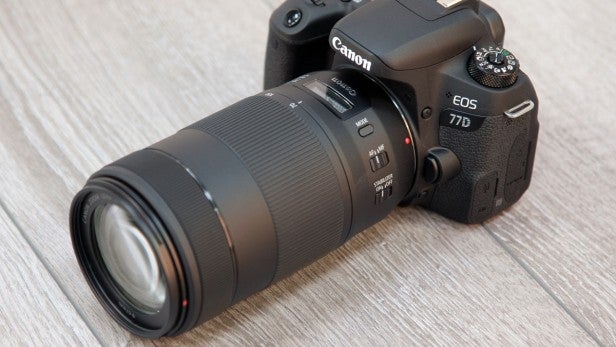
Surprisingly, though, information technology reports slightly smaller maximum apertures at intermediate zoom settings compared to its predecessor – although the difference isn't of any applied concern. However, information technology uses less glass than Canon'southward upmarket 'Fifty'-series lens with the same zoom range, which is larger and heavier equally a result.
Internally, a 9-bladed diaphragm with curved blades gives a about-circular discontinuity for attractive groundwork mistiness. The minimum focus altitude is a shut 1.2m, bringing a magnification of 0.25x.
Its EF designation ways that this lens covers a full-frame sensor, making information technology an ideal partner to the EOS 6D or the recently announced EOS 6D Marker Ii. Of course, it can also be used on APS-C sensor bodies such every bit the EOS 80D, on which it will provide a 112-480mm equivalent view.
The lens' most diverting feature, notwithstanding, is surely its new superlative-plate LCD panel. Pressing a button beside this sees the display cycle through three modes: focal length (shown as 35mm equivalent on ingather-sensor bodies), a camera shake meter in two dimensions, and the current focus distance complete with a simple depth-of-field scale.
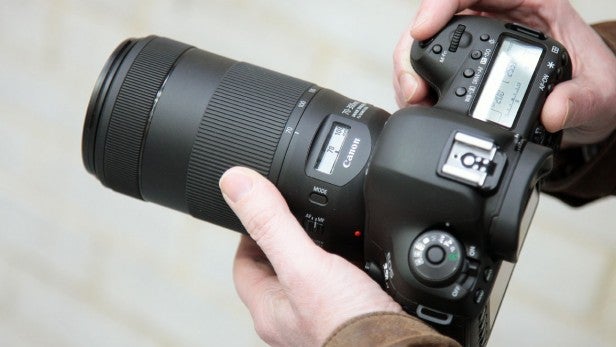
Holding the button for a second switches between dark lettering on a calorie-free groundwork and vice versa, while a longer printing turns the display off entirely. This is all technically very clever, and the brandish does a really convincing chore of updating in real-time as the zoom or focus is changed. But information technology isn't entirely clear what it's really useful for, especially since you lot can't run into the display when looking through the viewfinder.
At the front of the lens you'll find a 67mm thread for spiral-in filters, and around it there's a bayonet mount to attach the ET-74B hood. Shamefully, though, Canon doesn't include this in the box – instead expecting you to pay a staggering £fourscore for what is ultimately a cylindrical piece of plastic.
You lot'll certainly want a hood, since the lens can show severe flare when shooting into the light without one. Thankfully, the enterprising tertiary-political party maker JJC will sell you lot a clone for £fifteen – which I'd buy.
Canon EF 70-300mm f/4-v.vi IS II USM – Build and Handling
In a clear stylistic departure from Canon'south older lenses, this 70-300mm features a minimalist blackness plastic barrel with slightly fair printed labelling. The construction is lightweight without feeling too insubstantial, which means that lens balances nicely on cameras of all sizes. Still, you don't go whatever perks such as weather sealing.

The wide zoom ring covers most of the barrel, unusually including the plastic section in front end of the ridged rubber grip. In front end of it is a smoothly rotating manual focus ring, which doesn't rotate during autofocus.
Closer to the camera body are three switches, one to lock the zoom at the 70mm position (in other words, the lens's shortest physical length), ane to switch betwixt automobile and manual focus, and the tertiary to switch image stabilisation on or off. In that location's no separate panning mode.
Canon EF 70-300mm f/4-v.6 IS 2 USM – Autofocus
Canon has debuted a new autofocus motor on this lens, dubbed Nano USM, which drives an internal focus grouping. The business firm claims that it combines the speed of ring-type USM for stills shooting with the silence and precision of an STM motor for video. The good news, and indeed one of the lens' highlight features, is that this isn't just hype; the lens' autofocus is very impressive indeed.
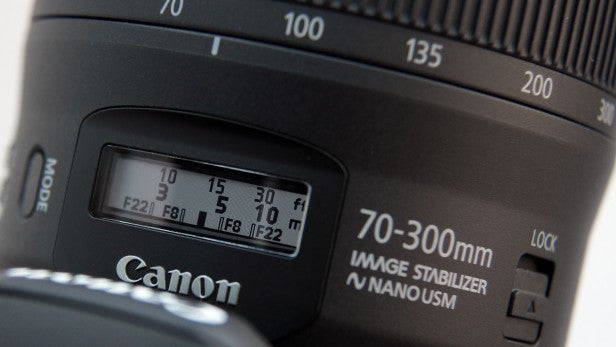
Indeed, focusing is incredibly fast – fifty-fifty when used on a relatively one-time DSLR trunk – nevertheless barely audible, even to the photographer in a quiet room. Compared to the previous generation lxx-300mm with its wearisome, buzzy Micro USM motor and rotating, extending forepart eyes, information technology's dark and day.
In general I found autofocus to exist consistently accurate likewise, on both the latest high-terminate EOS 5D Mark IV and the much older EOS 50D. However, you do have to pay actress attention to precisely where you place the AF signal, since depth of field is naturally very express.
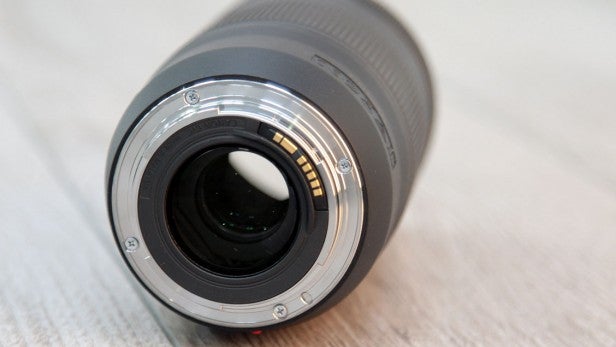
Manual focus is, like many lenses these days, electronically rather than mechanically coupled. This allows full-fourth dimension manual focus – in other words, you can arrange the focus manually when desired without having the pic the switch on the barrel to the MF position.
One quirk is that when you're using the camera'due south optical viewfinder, manual focus in only bachelor when the camera is turned on and activated by a one-half-press of the shutter button; all the same, switch to alive view and it's active all the time.
Canon EF 70-300mm f/4-five.vi IS II USM – Paradigm Quality
Examining the images I shot with the lens reveal it to be a very competent performer indeed. Tested on the thirty-megapixel full-frame EOS 5D Mark Four, it produces detailed images at all focal lengths, especially when used at the usual sweet spot around f/8-f/11.

The corners of the frame are noticeably soft and wide open up at 70mm, but with this kind of lens they'll oft exist out of focus anyway unless you cease down for extra depth of field. Nevertheless, while the lens offers some very small apertures – f/45 at 300mm, for example – going much further than f/xvi volition see a serious loss of sharpness due to diffraction.
Naturally, you lot'll see some vignetting wide open, along with visible distortion that's of the butt blazon at 70mm, turning to pincushion at longer focal lengths. At that place's as well visible colour fringing towards the corners due to lateral chromatic aberration. However, all of these flaws tin be readily stock-still using profiled lens corrections during raw processing, and in-camera with Canon's more recent DSLRs.

Out-of-focus backgrounds are rendered with by and large pleasing blur, although vivid highlights can sometimes wait hard-edged and 'decorated', particularly towards the long finish of the zoom. Indeed, I found that the lens' biggest flaw was the aforementioned stiff susceptibility to flare when shooting towards the sun.
Crucially for this type of telezoom, the image stabilisation turns out to exist pretty effective. I tested information technology while shooting in local bluebell forest, where the dense foliage cover makes light levels relatively low. This is the kind of situation where paradigm stabilisation can make a huge deviation, assuasive you to exploit slow shutter speeds to keep the ISO low and minimise image noise.

I found that prototype stabilisation allowed me to use shutter speeds around four stops slower than would otherwise be possible; for example, I fairly consistently accomplished sharp images at around 1/10sec at 70mm, and 1/30sec at 300mm.
Resolution
Our Paradigm Technology MTF tests reveal the lens to be a very creditable performer. Central sharpness is impressive, dropping simply slightly on zooming from 70 to 300mm. The corners are notably softer at 70mm, but improve on zooming longer. Overall, the sharpest results tend to exist obtained at f/viii and a stop either side.

Shading
Our tests reveal noticeable shading throughout the zoom range at maximum discontinuity, which disappears on stopping downwards to f/8. While the magnitude is similar at all focal lengths, the blueprint is noticeably more abrupt into the corners at 70mm. This ways it will exist more visually intrusive when shooting images that should exist fifty-fifty-toned across large areas of the frame.
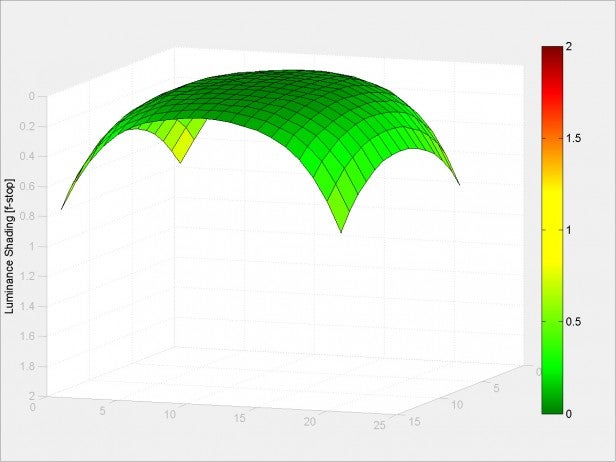
Canon EF seventy-300mmf/four-5.6 IS II USM corner shading at 70mm, f/four
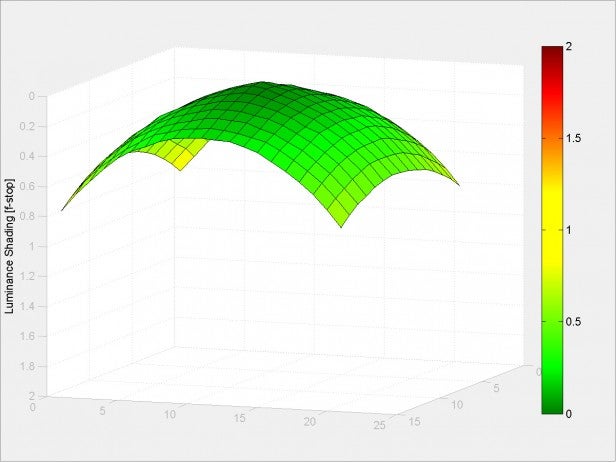
Canon EF 70-300mmf/4-5.vi IS II USM corner shading at 300mm, f/five.6
Curvilinear distortion
Typically for a telephoto zoom, the lens shows mild barrel distortion at its short end, changing to pincushion distortion at full zoom. I'd desire to correct for this when shooting geometric subjects, using either the in-photographic camera corrections available in modern EOS DSLRs, or lens profiles when shooting raw.

Canon EF 70-300mm f/4-5.6 IS Ii USM @ 70mm, -1.vii% TV SMIA

Canon EF seventy-300mm f/4-v.6 IS Two USM @ 70mm, 1.8% Goggle box SMIA
Should I purchase the Catechism EF lxx-300mm f/4-5.6 IS II USM?
With the EF 70-300mm f/iv-v.6 IS II USM, Canon has made a pregnant and much-needed update to its mid-range telezoom. Virtually importantly, it has vastly improved the autofocus compared to the previous version, and up-rated the image stabilisation likewise. This ways that it will deliver more 'keepers', either when shooting moving subjects, or hand-held in marginal lite. This in turn means you can become the most from the lens' very decent optics.
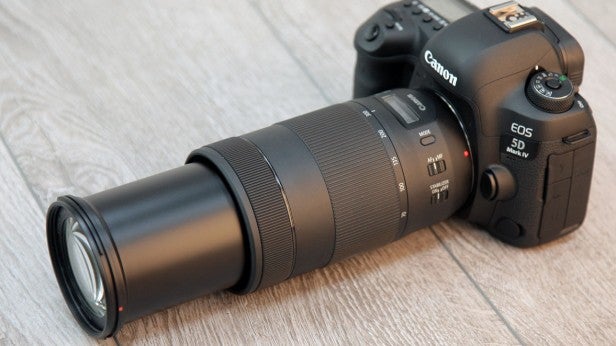
Build quality and handling are perfectly acceptable for the price indicate, but information technology would have been nice to encounter a seal around the lens mount. The LCD console on top of the barrel is certainly clever, although I'm not sure it brings many practical benefits on this detail lens.
It'southward inexcusable for Canon to expect buyers to fork out £75 extra for a hood, but with inexpensive clones available to buy online, this isn't equally serious a business as information technology might have been.
This lens is a great match to Canon's mid-range DSLRs, offer a great balance between portability and image quality.
Related: Best Cameras
Verdict
For the majority of Canon DSLR users looking for a lightweight telephoto zoom for everyday utilise, the Canon EF 70-300mm f/four-5.half dozen IS Ii USM is one of the obvious choices.
Trusted Score
conyersandeaphs1986.blogspot.com
Source: https://www.trustedreviews.com/reviews/canon-ef-70-300mm-f-4-5-6-is-ii-usm
0 Response to "Canon Ef 70-300 F4-56 Is Ii Usm Review"
Post a Comment